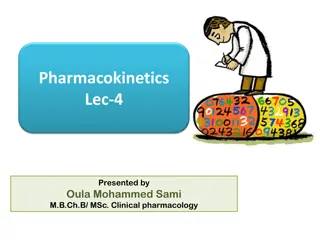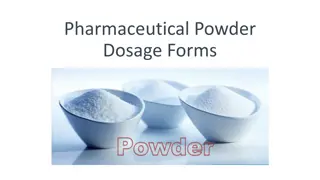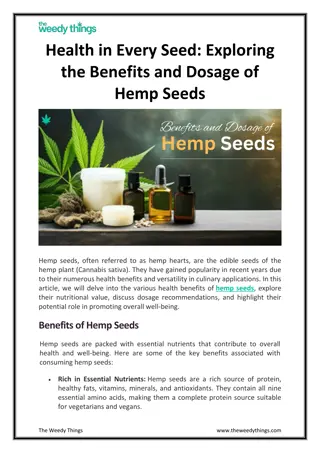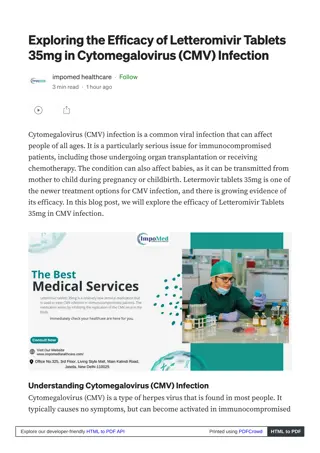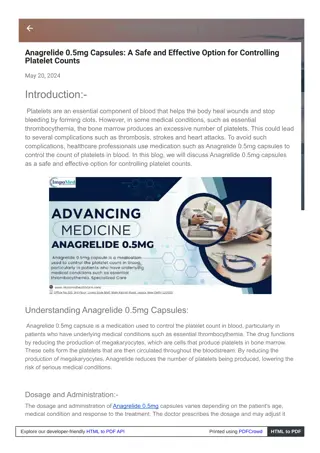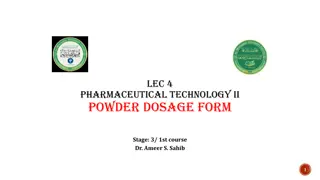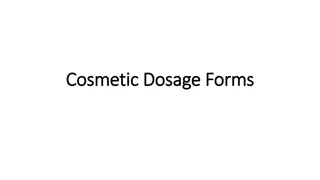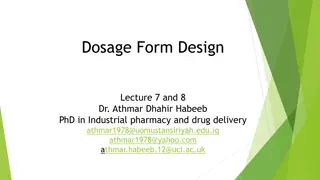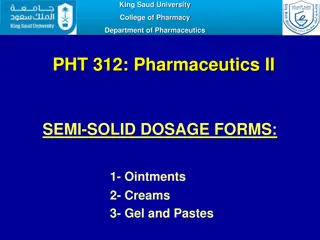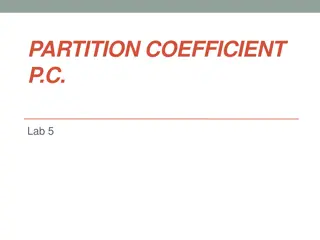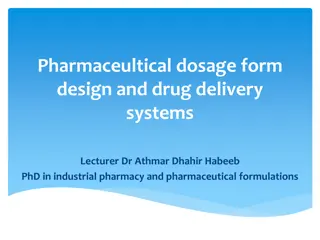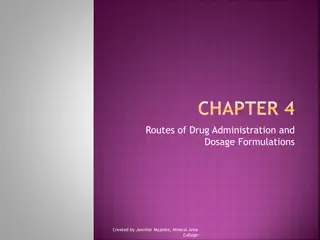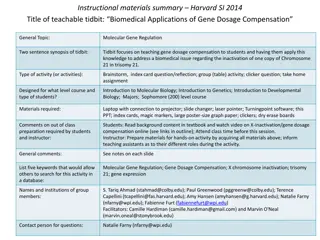
Semisolid Dosage Forms: Advantages, Disadvantages, and Ideal Properties
Learn about semisolid dosage forms, their definition, advantages, disadvantages, ideal properties, ingredients needed, and the bases used. Discover the uses and considerations of these topical medications in pharmaceutical applications.
Uploaded on | 1 Views
Download Presentation

Please find below an Image/Link to download the presentation.
The content on the website is provided AS IS for your information and personal use only. It may not be sold, licensed, or shared on other websites without obtaining consent from the author. If you encounter any issues during the download, it is possible that the publisher has removed the file from their server.
You are allowed to download the files provided on this website for personal or commercial use, subject to the condition that they are used lawfully. All files are the property of their respective owners.
The content on the website is provided AS IS for your information and personal use only. It may not be sold, licensed, or shared on other websites without obtaining consent from the author.
E N D
Presentation Transcript
StudyMafia.Org Semisolid Dosage Forms Submitted To: Submitted By: Studymafia.org Studymafia.org
Content Introduction Definition Advantages Disadvantages Uses Need Conclusion
Introduction Semi-solid means one substance which contains both solid and liquid. Semisolid dosage forms are also contain solid and liquid both. These types of dosage forms are viscous in nature. Normally used for topical or external application.
Definition Semisolid dosage forms are the topical dosage form used for the therapeutic, protective or cosmetic functions. It may be applied to the skin, nasal, vaginal, or rectal cavity. Examples of semi-solid dosage form: Ointments, pastes, cream, plasters, gels and rigid foams.
Ideal Properties Smooth texture Elegant in appearance Non-dehydrating Non-gritty Non-greasy and non-staining Non-hygroscopic
Advantages It is used externally The probability of side effects can be reduced First, pass gut and hepatic metabolism is avoided. Local action and Site-specific action of the drug on the affected area. Convenient for unconscious patients or patients to have difficulty in oral administration. Suitable dosage form for bitter drugs. More stable than a liquid dosage form
Disadvantages The accuracy can't be measured, for the semisolid dosage form. May cause staining. They are bulky to handle. Application with a finger may cause contamination. Physico-chemical is less stable than a solid dosage form. May cause irritation or allergy to some patients
Ingredients needed for semisolid dosage form Bases Preservative Humectants Antioxidants Emulsifier Gelling agent Permeation enhancer Buffers
Bases used in semisolid dosage form It is one of the most important ingredients used in the formulation of the semisolid dosage form. Ointment bases do not merely act as the carriers of the medicaments, but they also control the extent of absorption of medicaments incorporated in them. Ideal characterization of bases used in semisolid dosage form: They should be: Inert, non-irritating, and non-sensitizing. Compatible with skin pH and the drug. Good solvent and/or emulsifying agent. Emollient, protective, non-greasy and easily removable. Release medicament readily at the site of application. Pharmaceutically elegant and possess good stability
Classification of Bases: According to USP ointment bases are classified into four general groups: Hydrocarbon bases (oleaginous bases) (Petrolatum, Paraffin, Lanolin, etc.) Absorption bases (cold cream, anhydrous lanolin, etc.) Water-removable bases ( oil in water) Water-soluble bases (polyethylene glycol)
Preservatives used in semisolid dosage form Preservatives are used to inhibit the growth of contamination of microorganisms. Example: Para-hydroxybenzoate (parabens), phenols, benzoic acid, sorbic acid, etc.
Humectant used in semisolid dosage form The humectant is a hygroscopic substance used to increase the solubility of the active ingredient to increase skin penetration. It's also used to improve the hydration of the skin.
Antioxidants used in semisolid dosage form Oxygen has the capability to become a part of potentially damaging molecules called free radicals. Free radicals can attack the healthy cells of the body. It can break their structure and that's why the function is also affected. Example: Butylated hydroxyanisole, Butylated hydroxytoluene Ingredients that increase permeation: Skin can act as a barrier. There are various penetration enhancers that can help the drug to penetrate through the skin. Oleic acid
The emulsifier used in semisolid dosage form Emulsifiers are used to improve the stability of an emulsion by increasing its kinetic stability. It reduces surface tension and prevents coalescence. It helps to increase the viscosity at low concentration.
Emulsifying agents used in semisolid dosage form Sodium lauryl sulfate: Oil/Water emulsion - Sodium stearate and calcium stearate. Glyceryl monostearate: This is a weak Water/Oil emulsifying agent and it is used as a stabilizer and emollient in the Oil/Water emulsion.
Buffers used in semisolid dosage form Buffers are added for various purposes. Such as (i) Compatibility with skin. (ii)Drug solubility. (iii)Drug stability. (iv)Influence the ionization of drugs.
References Google.com Wikipedia.org Studymafia.org Slidespanda.com
Thanks To StudyMafia.org

